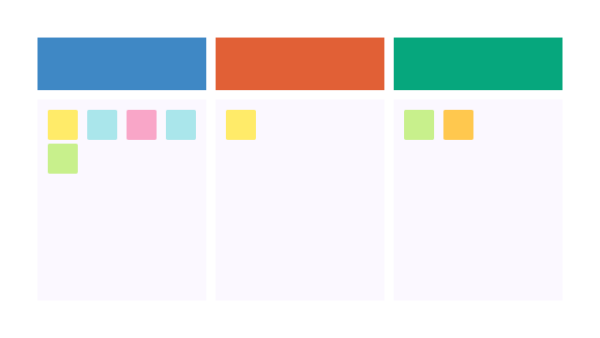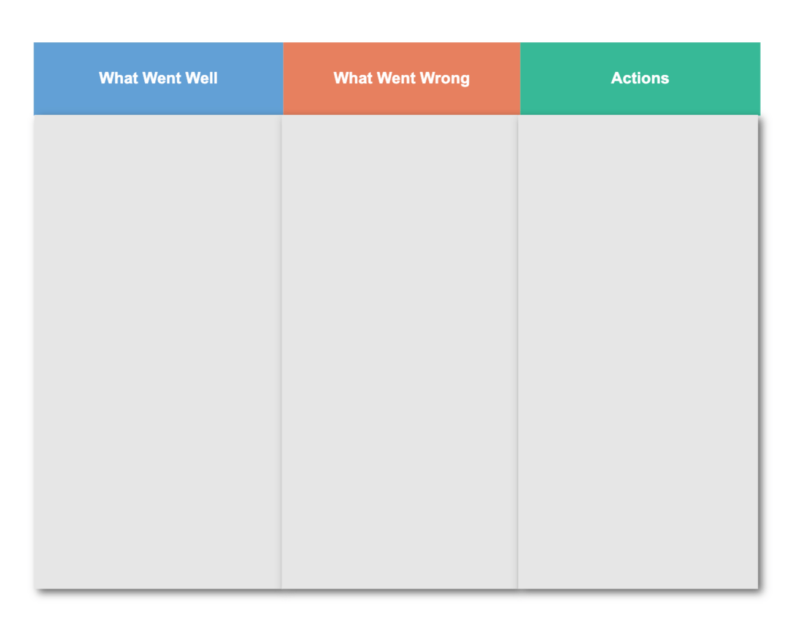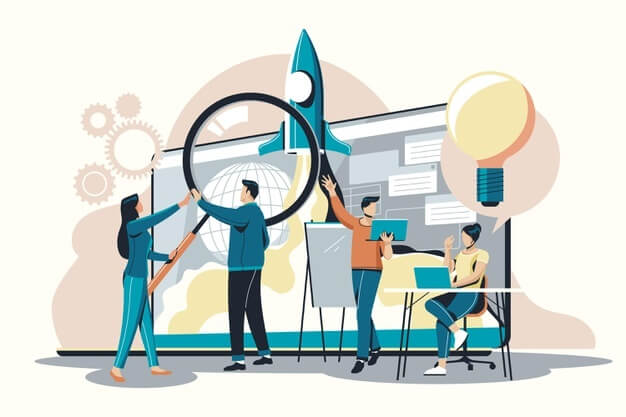People famously say “Those who fail to learn from history are doomed to repeat it”, and while this is a very deep philosophical statement, there is a lot of truth in it for businesses and product teams. If you aren’t willing to look back at your previous work you will never learn from your mistakes and they will keep following you into the future. This can be avoided, however, by using a retrospective analysis to analyze previous projects and plan for success in the future.
In this article, we will talk about why people conduct retrospective analyses so often and will highlight some of the best retrospective templates that you can use with online whiteboards.
7 Best Retrospective Templates
Retrospective templates are some of the simplest boards that can be used during both visual collaboration sessions and virtual workshops, and despite being incredibly simple, they’re also super effective at targeting important goals and streamlining your workflow.

Through any type of layout or structure, retrospective analyses usually share a common goal. These templates target the optimization of future projects through the lens of past successes and failures. By analyzing your previous scenarios you can access the details of what went well and what should be avoided in the future. Retrospective templates take multiple different forms and can yield different results based on the specific structure that you choose, but they all share that same end goal.
Knowing that retrospectives share end goals and are meant to target different things, it can be confusing to understand which retrospective to use and how you should implement them to get the most out of your team. Below we will define, explain, and position 7 different retrospectives so, hopefully, you will have a better understanding of what they are and how to use them.
1. Traditional Retrospective
The first retrospective we’ll cover is the most traditional version of the retrospective analysis and it’s the one we have pre-made on IdeaScale Whiteboard. This version is also commonly referred to as the “start, stop, continue” retrospective. This is an easy way to understand this template, and the main principle behind this retrospective is finding things from your previous sprint that you want your team to start doing, stop doing, and continue doing.
This retrospective is very task-oriented and in order to find things that fit in each category you need to brainstorm the actionable tasks that went into the last project and analyze their efficacy.
This doesn’t have to begin and end at tasks; it can also include habits, meeting practices, or general organizational factors that either helped or hindered the overall ability of your team to conduct a successful sprint.

Specifically, our traditional retrospective takes a slightly different view to the “start, stop, continue” practice and thinks more about what went well, what went wrong, and actions that can be taken based on that feedback. This is a great forum for people to air their frustrations, walk through the steps of their last project, or begin a dialogue on how to best move forward. If you only want to use one retrospective template, this is the one for you.
2. Emotive Retrospective
While the traditional retrospective focuses mainly on actionable tasks and how your team can transition actions into future projects, the emotive retrospective takes a closer look at how people felt about the previous project.
Sometimes a project plan can look flawless before it’s implemented, and once you begin working it turns out there are some tensions or dynamics that are very abrasive towards the success of the team. It’s important to gauge people’s feelings about their work when projects go wrong to best understand their perspective and change things going forward.
Not only is this important when projects fail, but even when projects are a success team members can often have frustration about how the project came to fruition. This is why it’s always important to assess people’s feelings both before and after the project is finished to find the correct wavelength for your team to operate on.
The emotive retrospective focuses on a “Glad, Sad, Mad” organization to designate what people were happy about, and what left them with more annoyance. This organization is both similar and different to the traditional retrospective and helps teams align themselves properly.
3. Roadblock Retrospective
The roadblock retrospective is a unique take on the traditional template that focuses on two main elements: what worked well and what led to a roadblock.
It’s more commonly known as the Working and Stuck retrospective template and it allows team members to look back on what actively pushed them towards project completion and what tasks/events led to them being stuck and less efficient.
With this template, people are able to work together to make all of their tasks more efficiently and effectively target the best way to see a project through to completion. Not only do you find a way through to completion, but the entire team does it together.
4. Learning Retrospective
Most retrospectives allow you to plan a more efficient path forward and look at the mistakes of the past, but the learning retrospective is all about the lessons learned from these mistakes.
Not only are you creating actionable ways forward, but you’re taking the time to analyze the specific lessons that you can take away from previous projects.
When highlighting these lessons, your team is able to find neutrality within what went well/what went wrong and is able to better embrace these changes. This section may leave room for not only actions that went wrong, but overall processes that affected the project but might not fall into any specific category.
This template demonstrates the importance of learning from the past when conducting future sprints and being able to adopt the lessons learned on a team scale.
This means that while the traditional retrospective is very black-and-white, the learning retrospective allows some neutrality for people to learn and grow from previous sprints.
5. Momentum Retrospective
Sometimes it’s most important to focus on the big wins of your last project. Honing in on the wins can help create momentum from your last project and carry forward the winning mentality to your future sprints.
Building on your previous wins lets your team focus on what went right and attempt to replicate these features in your next activity. When thinking about elements of success of your most recent project, think about both the actions that led to the success and the teamwork that allowed it to happen.
The momentum retrospective helps create progress after every sprint and begins building a culture of winning within the team. When using this template try to organize all of the personal and shared wins that went into the last project and identify actionable changes that you can make to the future sprints to enable these wins to repeat.
6. Team Favorites Template
Similar to the momentum retrospective, the favorites retrospective narrows the view to just the items that people liked the most from their previous sprints.
These could be anything from the actual tasks they accomplish to the teamwork they do, to even the end product they’re working towards. Whatever it may be, it’s important to emphasize that the interests of the team are just as important as the winning behavior that gets the job done.
By emphasizing people’s favorite parts of previous projects, you begin to brainstorm ways that these items can be integrated into future sprints, making the process more effective and enjoyable for everyone involved.
This is super helpful to build team cohesion and make sure everyone is getting personal fulfillment out of the work they’re doing. This means that people feel like their needs are prioritized as you move forward and you’re able to help incorporate what everyone wants into the next project.
7. Product Comparison Template
The comparison retrospective is a fun exercise that asks your team to compare your most recent project to a product and align the values and quality of the sprint to this product. This retrospective is a good way to loosen up the team and get people talking about what went well and what went wrong.
The most common example of a comparison retrospective is using cars. If the sprint went well and produced a high-quality product, you might compare it to a Bentley. If it was very standard, you might compare it with a Ford. This gives people a fun activity to do while also looking back on the quality and success of the previous project.
By doing this exercise people feel they can accurately compare their feelings about the previous sprint to something everyone understands and through this foster a greater sense of communication and togetherness within the team.
Learn more: What is a Values Retrospective?
Conclusion
Hopefully, this guide has helped outline how helpful retrospective templates can be within the workplace and how you can integrate them into your next project. If you want to learn even more about retrospectives, check out our article on the values of retrospectives.
Most Recent Posts
Explore the latest innovation insights and trends with our recent blog posts.













